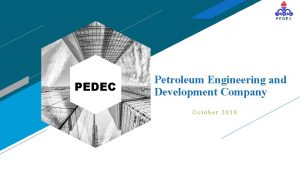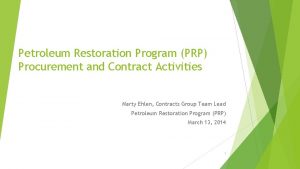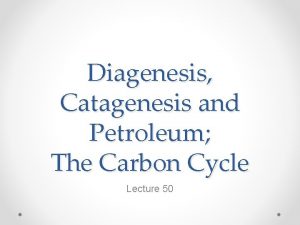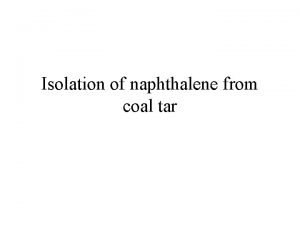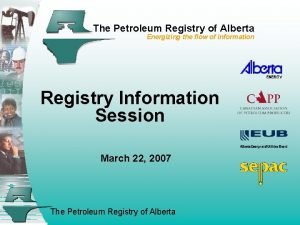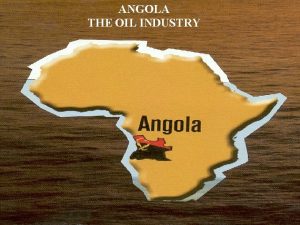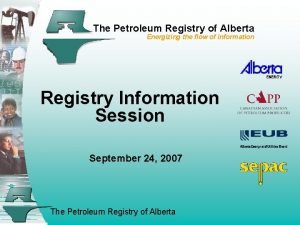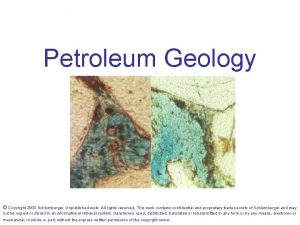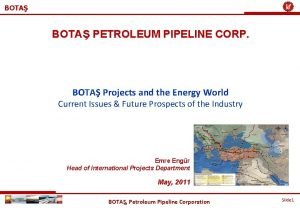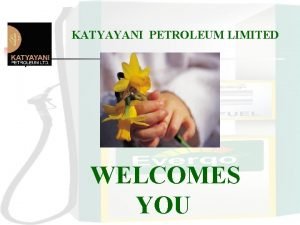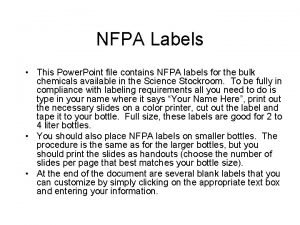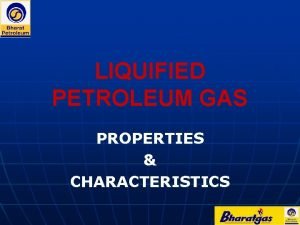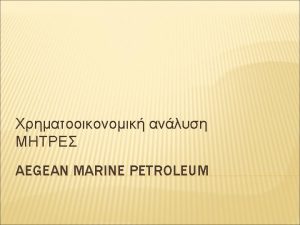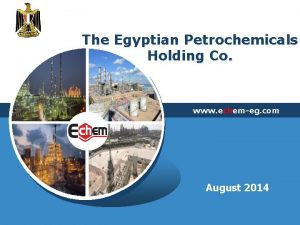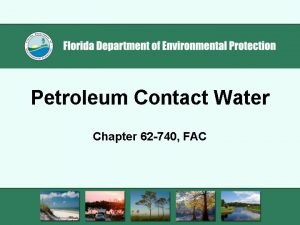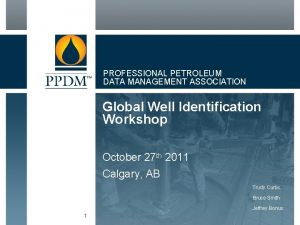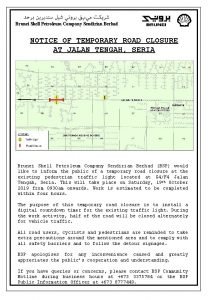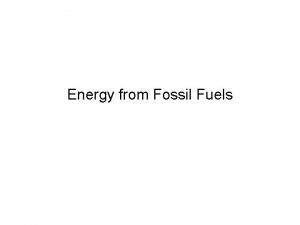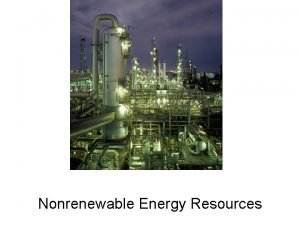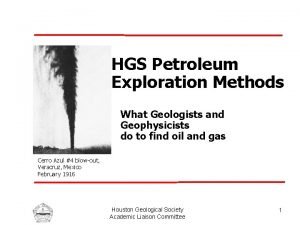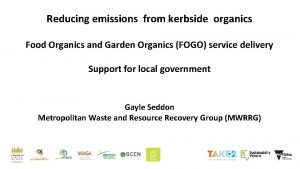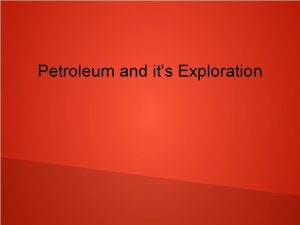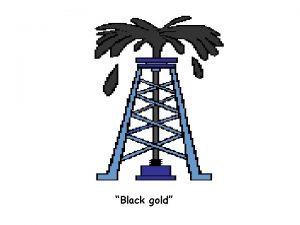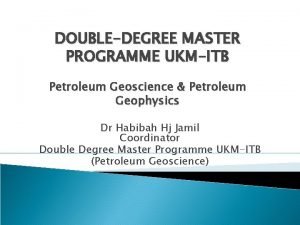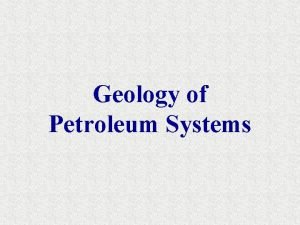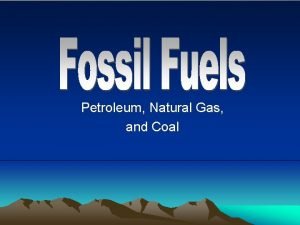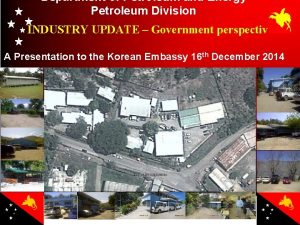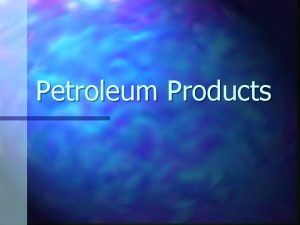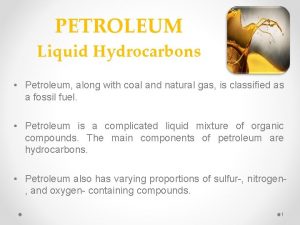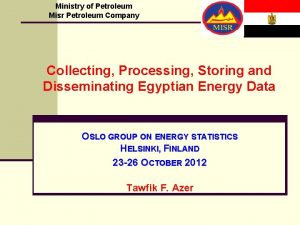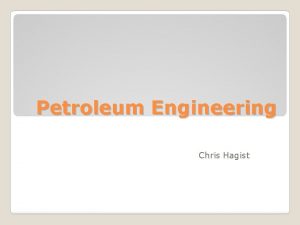Organics to petroleum What are the major differences



































- Slides: 35

Organics to petroleum What are the major differences in the general organic chemistry of terrestrial vs. marine organic matter? What are the important steps in the maturation of marine organic matter to form petroleum? Under what conditions of burial do these step occur? What are the major groups of organic compounds present in petroleum? What is the relationship between molecular weight and behavior of petroleum hydrocarbons? What is a ‘petroleum system’? How does the geothermal gradient influence petroleum maturation? What are petroleum ‘traps’? How do we locate them? What methods are used to define the extent of petroleum reservoirs? What is overpressure? What is a Hubbert Curve?

organics clastic sediment terrestrial marine/lacustrine

marine/lacustrine organics: phytoplankton, zooplankton; “sapropel”; fats, resinous, waxy terrestrial organics: vascular plants: “humic”; cellulose, lignin, carbohydrates

marine organic matter H: C ratio 20 o. C carbon dioxide evolved (decarboxlyation) kerogen methane evolved km buried 1. 0 60 o. C 2. 0 90 o. C petroleum liquids asphalt, bitumen 120 o. C 200 o. C 3. 0 4. 0 5. 0

alkanes – paraffin, straight – chain hydrocarbons

aromatics – more soluble in water, smelly, toxic

cycloparaffins - napthenes




Burial depth and local geotherm determine the maturation of petroleum hydrocarbons. The hydrocarbon systems in central NY reached temps of 140 +, so most of the local rocks yield natural gas.

Finding oil: the first oil wells were located in the vicinity of natural oil seeps. Natural oil seeps were used for millennia as sources of tar and lubricating oils.

Some types of petroleum traps.



Cuttings Rotary drill bit A rotary drill is attached to a drill stem. The rotation of the bit is driven by drilling mud pumped down the drill stem. The returning mud lifts cuttings from the well and cools the drill bit.

Coring of the well during drilling is expensive – note the diamonds. Cores provide information about the details of rock structure and composition.

Well ‘development’ – improving the permeability of the reservoir.


Many oil and gas reservoirs are 1000’s of feet beneath the surface, and in offshore settings, under 100’s to 1000’s of feet of water. Finding petroleum reservoirs requires very precise location and definition of subsurface rock masses.

Numerous, stacked oilbearing reservoirs. These may be interconnected and thus require sequential development.

Well logs are representations of the rock and fluid properties in a well. Lateral correlations of well logs help to define the structure and stratigraphy of source beds, reservoir beds and cap rocks.


Maps of porosity and permeability help define future drilling sites.

Isopach maps define thickness of reservoir beds.

Past productivity trends help define future development of a reservoir.

Reflection seismic data is critical to subsurface exploration.

Wellhead pressure is provided by gas and water in the subsurface. Post-extraction treatment removes water and separates gas from oil.

Secondary treatment involves pumping of water or gas into wells that force oil into the extraction wells.

The circled well is the Mary Sudik #1, drilled by the Indian Territory Illuminating Oil Company in Oklahoma. On March 26, 1930, this well blew out at 6, 470 feet. The force blew 20 pieces of heavy 30 -foot drill pipe out of the hole! The "Wild Mary Sudik" was finally plugged off 11 days after blowing out, through the heroic efforts of dozens of people. Six years later, the. Sudik lease had produced five million barrels of oil !

Overpressure may result in well ‘blow-outs’ ‘Christmas tree’ valve systems control well head pressure.

The Hubbert curves for petroleum discovery and production.

Historical influences on crude oil prices.

marine organics: phytoplankton, zooplankton terrestrial organics: vascular plants

Coal Rank H 2 O Peat 20 o. C Lignite 50 o. C Sub-bituminous o. C 80 Bituminous Anthracite 160 o. C Graphite 240 o. C H: C ratio Methane evolved
 Antigentest åre
Antigentest åre Midwest organics recycling
Midwest organics recycling Petroleum facts
Petroleum facts Petroleum equalisation fund
Petroleum equalisation fund Petroleum engineering and development company
Petroleum engineering and development company Prp procurement
Prp procurement Petroleum
Petroleum Catagenesis in petroleum
Catagenesis in petroleum Isolation
Isolation Pllite
Pllite Ufa state petroleum technological university
Ufa state petroleum technological university Petroleum ether composition
Petroleum ether composition Angola
Angola Petroleum and natural gas formation
Petroleum and natural gas formation Petroleum registry
Petroleum registry Petroleum system
Petroleum system Botas petroleum pipeline corporation
Botas petroleum pipeline corporation Katyayani petroleum ltd
Katyayani petroleum ltd Petroleum ether nfpa
Petroleum ether nfpa Statoil
Statoil Liquefied petroleum gas properties
Liquefied petroleum gas properties Florida petroleum council
Florida petroleum council Aegean marine petroleum network inc
Aegean marine petroleum network inc Nickey petroleum
Nickey petroleum Pros and cons of petroleum engineering
Pros and cons of petroleum engineering Egyptian petrochemicals holding company
Egyptian petrochemicals holding company Fac
Fac Professional petroleum data management association
Professional petroleum data management association Brunei shell petroleum
Brunei shell petroleum What are the environmental impacts of fossil fuels
What are the environmental impacts of fossil fuels Petroleum geoscience
Petroleum geoscience Independent petroleum association of new mexico
Independent petroleum association of new mexico Petroleum is a complex mixture of
Petroleum is a complex mixture of Advantages of petroleum
Advantages of petroleum Chemical and petroleum solutions
Chemical and petroleum solutions Petroleum product
Petroleum product




